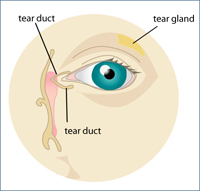 Chronic dry eyes is a condition where the eyes are not able to produce enough tears to lubricate themselves, leading to discomfort and overall lower quality of vision. Though this condition is extremely common, it is most often found in avid computer users, individuals who wear contacts, those older than 55, and previous eye surgery patients. Dry eye can make it more difficult to perform day-to-day activities and can become more aggravated in dry environments, such as the air inside an airplane.
Chronic dry eyes is a condition where the eyes are not able to produce enough tears to lubricate themselves, leading to discomfort and overall lower quality of vision. Though this condition is extremely common, it is most often found in avid computer users, individuals who wear contacts, those older than 55, and previous eye surgery patients. Dry eye can make it more difficult to perform day-to-day activities and can become more aggravated in dry environments, such as the air inside an airplane.
What Are the Symptoms of Dry Eye?
Symptoms of dry eye can be any of the following:
- pain and redness
- stinging or burning
- feeling as if something is in the eye
- discharge
- inability to cry
- blurred vision
- heavy eyelids
- feeling discomfort with contact lenses
- decreased tolerance while reading or working on the computer
What Are the Causes of Dry Eye?
Dry eye can be a side effect of various different factors. The condition can be caused by some medications, including nasal decongestants, tranquilizers, certain blood pressure medicines, antihistamines, antidepressants, birth control pills, and Parkinson’s medications. Diseases can also be a contributing factor – skin disease on or around the eyes can result in dry eye symptoms, as can diseases in the glands of the eyelids. Immune system disorders such as lupus and rheumatoid arthritis also lead to dryness in the eyes. Hormone changes can also lead to this, specifically showing in women who are pregnant, women who are on hormone replacement therapy or women taking estrogen.
Trauma or surgical procedures can also play a role in dry eye symptoms. Dry eye can be known to develop after LASIK surgery, though the symptoms are generally short-term in this case. Any trauma to the eye, such as chemical or thermal burns, can damage the membrane lining the eye and lead to loss of tearing.
Finally, there are day-to-day factors that have the possibility of contributing to dry eye symptoms. Allergies are a common factor, and more recently staring at a computer or video screens for long periods of time causes infrequent blinking and thus produces less tears. Long-term contact wear is a common cause, as is exposure keratitis, which is when the eyelids do not completely close during sleep. Long-term exposure to chemical fumes, tobacco smoke, or drafts from air conditioning and heating can be main factors in the long run as well.
How Can I Treat Dry Eye?
There are various treatments for dry eye, ranging from simple lifestyle changes and over-the-counter medications to surgical procedures depending on the severity of the case.
To schedule a consultation, please contact us at Aesthetics by OCLI VISION today!



